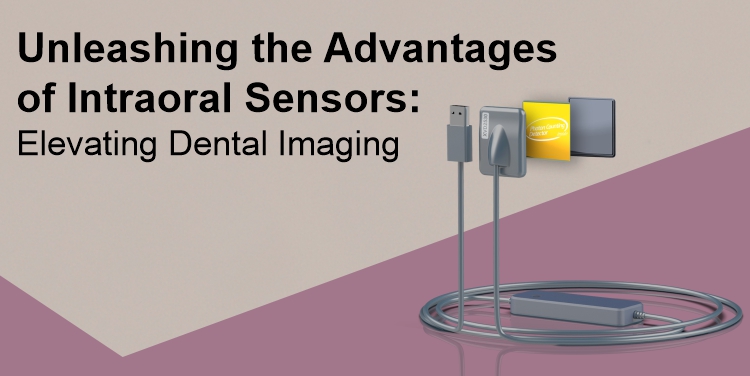Unleashing the Advantages of Intraoral Sensors: Elevating Dental Imaging

Welcome to dental imaging innovation, where intraoral sensors redefine how dentists capture and analyze diagnostic images. In this blog, we will explore the advantages of intraoral sensors in dental imaging. From enhanced image quality to time management and reduced radiation exposure, intraoral sensors have transformed the dynamics of dentistry. Join us as we delve into the remarkable benefits of these sensors and discover why they are a game-changer in dental practices.
Intraoral sensors are advanced imaging devices that capture detailed images of teeth and oral structures. These sensors are essential to digital dental radiography, replacing traditional film-based methods. They offer a more efficient, accurate, and patient-friendly approach to dental imaging. With their compact size and advanced technology, intraoral sensors have become a crucial tool in modern dental practices.
Advantages of Intraoral Sensors:
Enhanced Image Quality: Image quality is paramount in dental imaging, as it directly affects diagnosis and treatment planning. Intraoral sensors deliver exceptional image quality, allowing dentists to visualize even the minutest details. With high-resolution imaging and advanced sensor technology, dental professionals can accurately detect and analyze dental conditions, leading to precise treatment outcomes.

Time Management: Time is of the essence in dental practice, and intraoral sensors significantly contribute to improved time management. With the ability to capture instant images, dentists can quickly assess patients’ oral health, make prompt diagnoses, and devise effective treatment plans. This efficiency enhances patient care and optimizes the workflow, allowing dentists to serve more patients effectively.

Reduced Radiation Exposure: Patient safety is a top dental priority, and intraoral sensors prioritize minimizing radiation exposure. Compared to traditional film-based radiography, intraoral sensors require significantly lower radiation doses to obtain high-quality images. Reducing radiation exposure ensures patient well-being while providing accurate diagnostic information for effective treatment.

Patient Comfort: Intraoral sensors prioritize patient comfort during imaging procedures. These sensors are designed with rounded edges and ergonomic shapes to ensure a smooth and comfortable patient experience. Additionally, intraoral sensors eliminate the discomfort caused by bulky film packets or uncomfortable positioning, resulting in a more pleasant dental visit for patients.

Environment-Friendly: Intraoral sensors contribute to a greener and more sustainable dental practice. With digital imaging, there is no need for chemical processing or film disposal, reducing waste and environmental impact. Dental procedures can embrace eco-friendly solutions by adopting intraoral sensors while delivering superior patient care.
Improved Patient Education: Clear and detailed images captured by intraoral sensors facilitate effective patient education. Dentists can visually explain dental conditions, treatment options, and expected outcomes, empowering patients to make informed decisions about their oral health. The visual impact of high-quality images enhances patient understanding, leading to improved compliance and better treatment outcomes.

Higher Conversion Ratio: Intraoral sensors are vital in-patient communication and case acceptance. By providing patients with immediate access to high-resolution images, dentists can visually demonstrate the dental conditions, highlighting the urgency of treatment. This visual evidence increases patient trust, leading to a higher conversion ratio of treatment acceptance.
How Intraoral Sensors Have Changed the Dynamics of Dentistry: The integration of intraoral sensors has revolutionized dentistry in several ways:
Enhanced Diagnostic Capabilities: Intraoral sensors provide dentists with an unparalleled ability to diagnose dental conditions accurately. The high image quality and detail these sensors capture enable precise identification of cavities, periodontal infections, and other oral health issues. This diagnostic capability allows for targeted treatment planning and improved patient care.
Minimized Radiation Exposure: With advanced sensor technology, intraoral sensors significantly reduce radiation exposure during dental imaging. This ensures patients’ safety and well-being while still delivering exceptional diagnostic images. The minimized radiation exposure makes intraoral sensors an ideal choice for pediatric patients and individuals with radiation sensitivity.
Time and Cost Efficiency: Intraoral sensors optimize dental workflows by reducing the time required for image acquisition and analysis. Rapid image capture and instant image availability enable prompt diagnosis, allowing dentists to provide efficient treatment plans and reduce chair time. Moreover, eliminating film processing and storage reduces operational costs, making intraoral sensors a cost-effective investment for dental practices.
Enhanced Communication and Collaboration: Intraoral sensors facilitate seamless communication and collaboration among dental professionals. The ability to share digital images instantly allows for remote consultations, interdisciplinary treatment planning, and referral cases. This enhanced collaboration ultimately leads to comprehensive, patient-centered care.
Which Intraoral Sensor is the Right Choice for Dentists? When choosing an intraoral sensor, several key factors should be considered:
Resolution and Image Quality: Evaluate the sensor’s resolution and image clarity to ensure accurate diagnoses and precise treatment planning. Higher-resolution sensors capture finer details, providing superior image quality.
Radiation Exposure and Patient Comfort: Look for sensors prioritizing minimizing radiation exposure while maintaining image quality. Additionally, consider the sensor’s ergonomics and patient comfort features to ensure a positive experience during imaging procedures.
Compatibility and Integration: Ensure the intraoral sensor is compatible with your existing dental imaging software and equipment. Seamless integration allows for efficient image management and workflow optimization.
Durability and Support: Consider the durability and longevity of the sensor, along with the warranty and available technical support. Investing in a reliable sensor ensures long-term usage and peace of mind.
Wireless Capabilities: Opting for a wireless intraoral sensor enables effortless data transfer, eliminating the need for physical connections and enhancing flexibility in the dental operatory.
Cost Considerations: Evaluate the overall cost of the sensor, including any additional accessories or software required. Balance the features, image quality, and pricing to make an informed investment decision.
Reviews and Testimonials: Read reviews and seek testimonials from other dentists with experience with the intraoral sensor you are considering. Their feedback can provide valuable insights into the sensor’s performance, reliability, and user satisfaction.
Conclusion
In conclusion, Xpect Vision intraoral sensor has revolutionized dental imaging and transformed the dynamics of dentistry. Their advantages, including enhanced image quality, time management, reduced radiation exposure, patient comfort, environmental friendliness, improved patient education, and higher conversion ratios, make them valuable asset in modern dental practices. Dentists can now provide efficient, accurate, patient-centered care while embracing advanced imaging technology. Explore the possibilities of intraoral sensors and elevate your dental practice to new heights.


